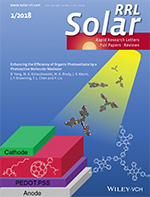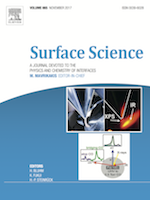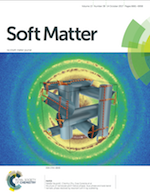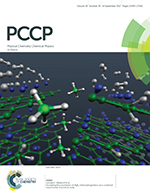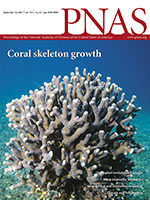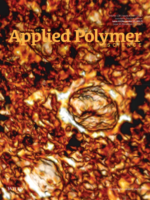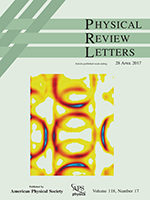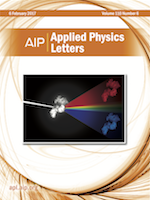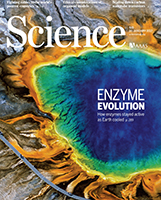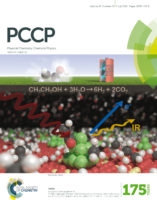In the search for high-efficiency organic solar cells, additives often play an important role in improving the film morphology. Liquid additives, while often effective, evaporate or migrate over time. Herein, Liu et al. report a solid photoactive molecular mediator that could be employed to replace the liquid additives to tune the morphology of bulk heterojunction films for improved device performance. Read more »
Journal Covers
CO Adsorption on Pd(100) Studied by Multimodal Ambient Pressure X-Ray Photoelectron and Infrared Reflection Absorption Spectroscopies
The first combined infrared spectroscopy and ambient-pressure XPS study was demonstrated at Beamline 11.0.2. The in situ vibrational and core-level spectroscopies in the Torr pressure range offer complementary information on the properties of surfaces and adsorbates while closing the pressure gap between laboratory measurements and applications. The multimodal spectroscopy also allowed the identification of the C 1s binding energy and quantification of an uncommon atop CO species on a Pd(100) surface. Read more »
Structure of Nanoscale-Pitch Helical Phases: Blue Phase and Twist-Bend Nematic Phase Resolved by Resonant Soft X-Ray Scattering
Resonant soft x-ray scattering (RSoXS) at the carbon K-edge was used to probe periodic structures of phases with orientational molecular order but homogeneous electron density distribution. This approach can be applied to structures with periodicities below the optical wavelength, to which neither optical nor classical x-ray diffraction techniques are sensitive. Read more »
Elucidating the mechanism of MgB2 initial hydrogenation via a combined experimental–theoretical study
Magnesium borohydride Mg(BH4)2 is a promising solid-state hydrogen-storage material, releasing 14.9 wt% hydrogen upon conversion to MgB2. Although several dehydrogenation pathways have been proposed, the hydrogenation process is less well understood. This study elucidates the key atomistic mechanisms associated with the initial stages of hydrogen uptake within MgB2. Read more »
Amorphous calcium carbonate particles form coral skeletons
Skeletons of Stylophora pistillata corals form by the attachment of amorphous calcium carbonate precursor particles, formed within the coral tissue, to the coral skeleton surface. This mechanism is faster than the precipitation of ions from solution and may render the corals less susceptible to ocean acidification than previously assumed. Read more »
In Situ Electrical Resistance and X-Ray Tomography Study of Copper–Tin Polymer Composites during Thermal Annealing
In situ electrical conductivity and x-ray tomography experiments were conducted on a conductive polymer composite containing polyvinylidene fluoride (PVDF) copolymer, copper (Cu), and tin (Sn) during thermal annealing. This study provides detailed insight into the morphological origins of the beneficial effect of thermal annealing on the electrical properties of conductive composites containing low melting metal fillers. Read more »
Electronic Phase Separation and Dramatic Inverse Band Renormalization in the Mixed-Valence Cuprate LiCu2O2
Angle-resolved photoemission spectroscopy was used to measure the electronic structure of LiCu2O2, a mixed-valence cuprate where planes of Cu(I) (3d10) ions are sandwiched between layers containing one-dimensional edge-sharing Cu(II) (3d9) chains. Read more »
Near-Edge X-Ray Refraction Fine Structure Microscopy
Soft x-ray ptychography was used to measure the absorption and refraction of x-rays through pristine reference materials as a basis for decomposing spatially resolved spectra from a heterogeneous sample, thereby quantifying the composition at high resolution. The novel method provided a nearly five-fold improvement in spatial resolution on resonance. Read more »
Evolutionary drivers of thermoadaptation in enzyme catalysis
With early life likely to have existed in a hot environment, enzymes had to cope with an inherent drop in catalytic speed caused by lowered temperature. Here, researchers characterize the molecular mechanisms underlying thermoadaptation of enzyme catalysis in adenylate kinase using ancestral sequence reconstruction spanning 3 billion years of evolution. Read more »
Ambient Pressure XPS and IRRAS Investigation of Ethanol Steam Reforming on Nickel–Ceria Catalysts
Ambient-pressure x-ray photoelectron spectroscopy (AP-XPS) and infrared reflection absorption spectroscopy (AP-IRRAS) have been used to elucidate the active sites and mechanistic steps associated with the ethanol steam reforming reaction (ESR) over Ni–CeO2(111) model catalysts. Read more »
- « Previous Page
- 1
- …
- 16
- 17
- 18
- 19
- 20
- 21
- Next Page »
